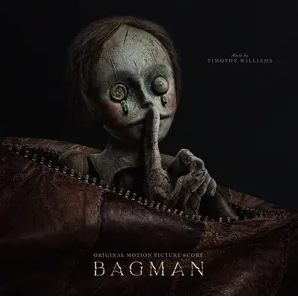1. Plot Summary
Patrick McKee (Sam Claflin) is forced to move back into his family home with his wife Karina (Antonia Thomas) and young son Jake after financial struggles. He begins hearing strange noises around the property, and when Jake wanders off near the woods, Patrick recalls the old legend of the Bagman—a mythical creature that kidnaps “good” children and stuffs them into a rotting sack.
As Patrick confronts his childhood trauma (he narrowly escaped the Bagman as a child), the creature re-emerges, threatening Jake’s safety and forcing Patrick to face the horror he’s tried to forget. The film builds toward a confrontation in an underground mine / stollen where the Bagman’s lair resides, with revelations about who is actually being hunted, what protections exist (e.g. totems), and whether Patrick’s past trauma ties directly to the creature’s return.
2. Notable Elements
What works / stands out
- The mythological premise using folklore (the Bagman / “man with the sack”) is compelling; it gives a familiar horror trope a touch of tradition and lore.
- The film leans on atmosphere, suspense, and dread more than overt gore (though it has unsettling creature design).
- Creature / monster design: The Bagman, often concealed by robes and a hood, is more effective when partially hidden; its eerie presence cuts better when not fully revealed.
- Some practical effects and visuals are praised; the lack of over-filtering (e.g. avoiding constant yellowish/post-apoc “horror filter”) is noted as a plus.
- The father-protecting-child dynamic is emotionally resonant: Patrick’s guilt, fear, and determination are emotional anchors.
What doesn’t quite land
- Predictability & clichés: Critics consistently point out that the film leans heavily on horror tropes (hidden monster, child in danger, haunted past) without offering many surprises.
- Thin / generic character writing: Many characters, including Patrick and Karina, are described as underdeveloped; they do what the plot requires but leave little lasting impression.
- Uneven pacing / reliance on exposition: The first half is more suspenseful; later, the film shifts into more explanation, flashbacks, and lore dumping, which undermines some mystery.
- Logical gaps / inconsistent rules: Some of the rules of the Bagman (e.g. how totems work, how the creature chooses its target) are introduced but not always consistently respected.
- Some critics argue the final scenes / twist feel abrupt or unsatisfying.
3. Themes and Messages
- Childhood trauma & recurrence: Patrick’s childhood escape from the Bagman haunts him, and the film suggests that unresolved fear can resurface when one least expects it.
- Protection, guilt, sacrifice: Patrick’s drive to protect his son (and make up for past failures) is central. The film wrestles with what may be asked of a parent in a supernatural crisis.
- The power / danger of folklore & belief: By treating the Bagman as real, the film positions belief—not just logic—as a force. Totems, legends, and old stories matter, and skepticism can be deadly.
- Innocence vs judgment / “good children”: The lore posits that Bagman targets “good” children; this raises uneasy ideas about behavior, value, and punishment.
- Fear of the unknown: Much of the horror operates in what’s hidden—shadows, rotting sacks, partial glimpses. The unknown is more terrifying than what is fully seen.
Regarding holiday or festive sensations: Bagman is thematically the opposite of holiday warmth. Its tone is dread, darkness, fear. However, one could contrast it to holiday films and say it intensifies appreciation for safety, family, and protection in peaceful times. The film’s emphasis on home, child safety, and parental responsibility might resonate more during times when family is foregrounded (holidays), but that’s more interpretive than intentional.
4. Personal Impressions
Strengths I appreciated:
- I like that Bagman leans into folklore rather than relying solely on cheap jump scares. The legend of the creature gives it a bit of texture.
- The emotional stakes matter when it anchors in the father–son relationship. Patrick’s fear is understandable.
- Visually, some scenes are haunting. The use of darkness, shadows, and partial reveals is often more effective than full exposure.
- The creature design, especially when hidden, is creepy. The hooded figure and its actions often evoke more dread than gore would.
Weaknesses I felt:
- Because the characters are not deeply drawn, at times I found myself less invested in their fates. When side characters disappear or react predictably, the surprise or horror doesn’t land as strongly.
- The shift to explanation / lore in the second half dulls some of the mystery. I prefer horror that leaves some questions open, but Bagman sometimes overcorrects with too much exposition.
- The ending / twist feels somewhat abrupt and leaves some threads unresolved in a way that’s frustrating.
- As some reviewers noted, the film sometimes uses visual and narrative tropes in a way that feels derivative.
5. Audience Recommendations
Who might enjoy it:
- Fans of supernatural horror and folkloric monsters (e.g. Bagman / Sack Man legends).
- Viewers who like horror with psychological and emotional elements, not just body horror.
- People who appreciate atmosphere, shadows, dread, and slow-building tension more than nonstop jump scares.
- Those who enjoy “reluctant hero” stories with family stakes.
Who might not:
- Those wanting completely fresh, unpredictable horror; Bagman leans on known tropes.
- Viewers who need strong character arcs and emotional depth for all characters—some are thin.
- Anyone averse to moments of ambiguity or unsatisfying resolutions.
- Viewers expecting constant scares; the film sometimes slows to build mood.
6. Conclusion & Rating
Bagman (2024) is a somewhat flawed but interesting horror entry. It has the strength of a compelling folkloric monster, decent atmosphere, and a core emotional center in Patrick’s struggle to protect his son. But it is held back by its familiar tropes, occasional pacing lulls, and uneven character work. It doesn’t fully rise above its genre—but for fans of supernatural, creeping horror, it offers some worthwhile moments.
Final Recommendation: Worth a watch if you like folklore-based horror and slower builds. Don’t expect a masterpiece, but you may walk away with a few images haunting you.
Star Rating: ★★½☆ (2.5 / 5)
Watch more:




